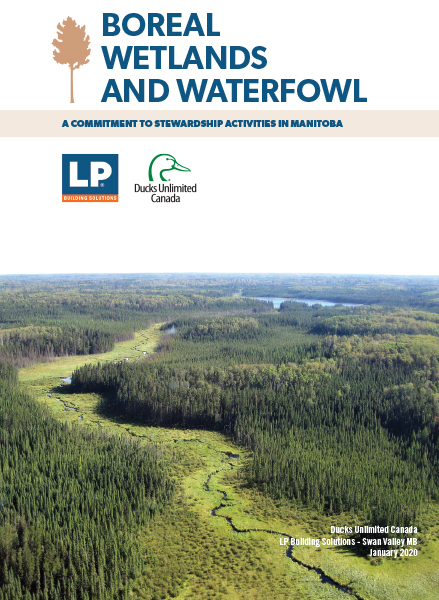Boreal Wetlands and Waterfowl: A Commitment to Stewardship Activities in Manitoba
Publication Type: Technical Report
Date: January 2020

What is it?
Louisiana Pacific Building Solutions (LP) and Ducks Unlimited Canada (DUC) have been working together in Manitoba’s boreal forest since 2001. In January 2020, LP and DUC officially decided they were going to continue working collaboratively to conserve 6.2 million acres of Manitoba’s boreal forest. From waterfowl research projects to developing novel methods of estimating carbon stores in boreal wetlands, staff and contractor training and forging the path ahead, this Stewardship Report will be your go-to document to ingest 18 years of accomplishments and conservation efforts in 44-pages.
Who is it for?
DUC openly welcomes collaboration with partners who believe that the way forward in conservation is to combine resources and share knowledge between industry, governments, universities, First Nations, and work to develop best management practices for our boreal wetlands. In working together, DUC and LP progressively move towards new ways of meeting conservation goals by relying on the expertise which both organizations possess. Read the report and delve into 18-years of partnership.
About the report
The Boreal Wetlands and Waterfowl Stewardship Report and its contents are the result of the efforts of many people from different organizations. The Report is an account of accomplishments carried out over an 18-year period in Manitoba’s boreal forest. It lists all projects undertaken, all report/guides and publications produced, and all training and best management practices developed. It also serves as a practical tool for all those who want an introduction to wetland mapping and inventory, or best management practices which support guiding principles for wetland stewardship. This report is a testament of what can be done when two organizations continuously strive to do better in the face of wetland conservation.
Excerpt from Page 15 of this resource
PLANNING BMPS
- Use wetland mapping and associated information when planning road and harvest block location and design to identify and avoid wetlands where feasible.
- Prioritize wetlands to avoid including: Non-merchantable wetlands and open water; Uncommon wetland types (e.g., wetlands that make up <5% of FML#3 including bogs and marshes), and; Wetlands with higher surface and subsurface water flow.
- Minimize the number of wetland crossings constructed during the non-frozen season.
OPERATIONAL BMPS
- When wetlands need to be crossed with a road, use techniques that accommodate natural wetland flow characteristics.
- Maintain vegetation zones (i.e. no harvest) or machine-free zones that retains standing vegetation adjacent to wetlands.
- Equipment should avoid wetlands, wetland transition areas, and areas adjacent to wetlands with saturated soils.
- Felled trees should be skidded away from wetlands.
- Avoid placing skid trails parallel to drainage paths.
- Log storage and processing sites should not be located on or adjacent to wetlands in locations where water will drain into a wetland.



